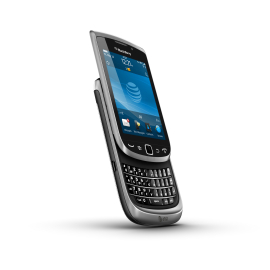There are 3 BlackBerrys now in the U.S., including:
- Next-generation Torch
- The touch-screen version of its smash-hit Bold phone
- The touch-screen-only phone called the Torch 9860.
Sprint Nextel said it too will be carrying the Bold and a variant of the all-touch-screen phone called the Torch 9850.
There are serious business and technology issues that should make you think twice before you buy one of the new ones unveiled today. From an operating system destined for irrelevancy to the continued lack of worthy applications, this latest line of smartphones from RIM may be dead on arrival. If you need to change phones, and your company isn’t forcing you to use a BlackBerry, you’re better off moving over to the iPhone or an Android smartphone.
Sounds harsh, but I’m not the only one down on the BlackBerry. According to a survey taken by NPD Connected Intelligence, roughly a third of those asked about their next smartphone said it would be either an Android handset or iPhone. A paltry 8 percent said they were looking for a BlackBerry. It’s hard to say that cost is the issue. While pricing isn’t available, they will likely be priced competitively with the iPhone and other high-end smartphones.
The latest BlackBerrys run on the newest version of its operating system, BlackBerry OS 7. While an improvement over past operating systems, in reality it represents only a minor update over OS 6, found in the original Torch that debuted a year ago. It was originally known as OS 6.1, but was renamed to 7 because the company claimed the update was so big. A more cynical person would suggest RIM was engaging in overly enthusiastic marketing to better sell its devices.
Big update or not, it’s not going to be around for very long. RIM said it is moving to its next-generation operating system, called QNX, next year. The software already powers the PlayBook tablet, which despite getting panned by reviewers, worked smoothly as an operating system.
If customers buy a BlackBerry now, they’re left with an operating system that will be out of date halfway through their two-year contract. Nokia is dealing with the same dilemma as it manages its transition to Microsoft’s Windows Phone operating system. In the meantime, the company is positioning its older Symbian platform as a mass-market smartphone phone.
There are other issues. Despite many attempts, RIM still hasn’t answered the increasing demand for applications. The iPhone and Android devices can do more than the basics of phone calls and Internet browsing, and it’s something that RIM continues to neglect. BlackBerry offers only a fraction of the number of applications available to iOS and Android users.
Last month, RIM said its App World had hit 1 billion application downloads, a significant milestone for the company but still behind its rivals. Apple earlier in the month said it had passed the 15 billion download mark, while Google said in May that more than 4.5 billion applications were downloaded through Android Market.
To be fair, RIM has hopefully addressed the hardware issues that have long plagued the devices, giving the new line a boost in specifications such as application processing speed and memory. RIM officials promised much of the same with the original underpowered Torch, but they appear to have delivered with the newest wave of SnapDragon-powered phones.
William Stofega, an analyst at IDC, said that the improved design of the Bold Touch will likely keep some of the BlackBerry faithful in the fold.
“It definitely fills a void in the portfolio that they didn’t have with the Storm,” he said.
And BlackBerry remains a good platform if all you’re interested in is access to e-mail and a higher level of security. It will remain a fixture in government agencies and companies with sensitive security requirements.
But if you’re looking to do more than simple e-mail and Web browsing, BlackBerry may not be your best bet.
Via [cnet]
If you found this post useful, dont forget to click the +1 button Below





